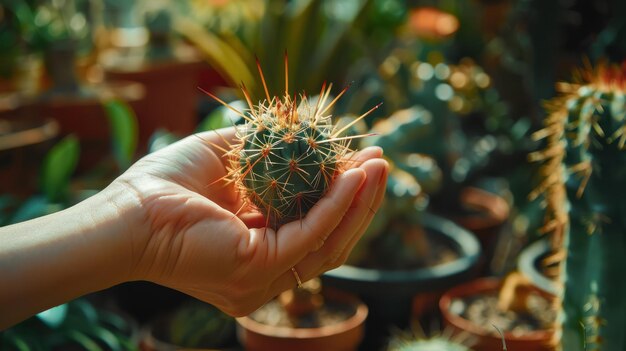In the verdant tapestry of North Carolina, a most intriguing and resilient inhabitant thrives amidst the gentle rolls of topography and the complex humidity. The cactus, often synonymous with arid deserts, finds its own unique niches even within the lush confines of this southeastern state. Embracing these enigmatic plants, North Carolinians can cultivate cacti which bear witness to their adaptive strategies, creating an exquisite interplay between flora and climate.
To understand the allure of cacti in North Carolina, one must first appreciate their inherent nature. Cacti are like nature’s architects, engineering their survival through exquisite adaptations. Their thick skin and reduced leaf structures allow them to conserve precious moisture, an undeniable paradox when one considers that they flourish in such a seemingly contrasting environment. In North Carolina, where humidity reigns and rainfall can be abundant, cultivating these resilient botanicals invites a delightful challenge for gardeners eager to stretch their horticultural capabilities.
As we delve into the intricacies of growing and caring for cacti in this region, it becomes evident that the journey is not merely about plant husbandry. It is a dance of understanding the soil, a waltz with the seasons, and a resonance with the rhythm of the natural world. The perception of cacti as mere decorative items belies the complex relationships that form between the grows, the ecosystems they inhabit, and the caretakers who nurture them.
The ideal habitat: finding the perfect balance
In the heart of North Carolina, where climate varies significantly across elevations and regions, discerning the most suitable locales for cacti becomes paramount. A basic understanding of the soil composition is essential, as these plants do best in well-draining substrates. Sandy or gravelly soils, rather than dense clay, become their preferred canvases—fertile ground for a myriad of species, including the striking prickly pear or the formidable opuntia.
To cultivate cacti artfully, one must fashion an environment where their innate characteristics can thrive. Cacti long for bright sun, much like a performer basking in the spotlight. Direct sunlight is non-negotiable; they should be placed in south or west-facing outdoor settings, where they can absorb the sun’s nourishing rays. Conversely, care must be taken to adjust exposure during the temperate humid summer months, ensuring they are not overwhelmed by excessive moisture that could precipitate roots’ demise—cacti are drought-tolerant but loathe to sit in soggy soil.
Meanwhile, the winter’s embrace presents yet another layer of complexity. Some varieties may require protection from the cooler temperatures that can dip below freezing, warranting a migration indoors or the creation of a microclimate within a greenhouse. The delicate balance of positioning and protection will help keep these plants flourishing, embodying the perfect harmony between nature and nurture.
The intricacies of hydration: loving without drowning
Watering, the fine art of interpreting thirst, emerges as a crucial aspect of cactus care. Too much moisture and a cactus finds itself engulfed in a watery grave; too little and it succumbs to desiccation. Understanding the rhythm of hydration is akin to a gardener’s meditation, honing the ability to observe and react to a plant’s subtle cues.
In North Carolina’s varied climate, occasional rainfall may suffice, but drought periods require additional watering attention. During the growth season, from late spring to early fall, it is prudent to irrigate cacti every couple of weeks, allowing the soil to dry completely between watering sessions. This cadence mimics the natural cycles these plants have adapted to across their native ranges. In winter, however, their need for hydration diminishes drastically, suggesting a seasonal repose in which they can gather energy for the burst of growth to come.
Cacti as art: choosing the right species
Cacti can become the living brushstrokes upon the canvas of your garden, offering visual intrigue and tactile experiences. Selecting species suitable for North Carolina can be an adventure unto itself, as they range from diminutive to monumental, each with its own aesthetic and ecological narrative. The opuntia species, with its vibrant pads and edible fruits, can thrive beautifully in gardens and may even invite local wildlife. Meanwhile, the echinocactus variety, with its sculptural spirals and charismatic spines, adds a touch of exotic elegance.
Moreover, incorporating different species can result in a compelling tableau that evolves with the seasons. As cacti bloom in stunning bursts of color amidst their otherwise stoic green forms, they introduce an ephemeral beauty—a metaphor for resilience and renewal that resonates profoundly in the hearts of their caretakers.
Beyond aesthetics, cacti also provide a unique educational opportunity for gardeners, allowing them to explore the delicate balance of ecosystems and the role these hardy plants play within them. They promote discussions around conservation and the broader implications of climate change and biodiversity, solidifying their status not just as ornamental companions but as vital contributors to our understanding of environmental stewardship.
In closing, nurturing cacti in North Carolina transcends simple gardening; it becomes a journey of discovery and kinship with plants that teach resilience through their very existence. They stand as vibrant symbols of adaptability—the unsung heroes of the botanical world—inviting us all to explore the nuanced relationships between our cultivated landscapes and the wild wonders of nature. So, whether through the lens of artistry or the pursuit of horticultural prowess, embracing these remarkable plants will invariably enrich the lives of those who venture to grow them.





Leave a Comment